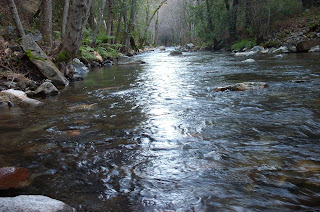Aricle published by the San Francisco Chronicle. Posted below in its entirety.
To read the article on the Chronicle's website,
click here.
By Kelly Zito, Chronicle Staff Writer
Tuesday, September 29, 2009
(09-28) 19:38 PDT -- Thirty years ago, a chunk of chain, an eyebolt and Mark Dubois helped end the era of big dam building in California.
Dubois, a bearded, 6-foot-8, 30-year-old river guide from Sacramento, chained himself to a rocky outcropping on the north bank of the Stanislaus River and stayed there for a week, determined to prevent the U.S. Army Corps of Engineers from filling the canyons behind New Melones Dam and submerging the limestone caves, verdant meadows and petroglyphs of the river valley.
Dubois lost that fight: New Melones had been approved in the 1940s and was well under way when he and the nascent Friends of the River got involved. But he and hundreds of others who celebrate the 30th anniversary of the Stanislaus Campaign next month believe their work is echoing through a new generation as another dam debate emerges in California.
"We didn't win 30 years ago, but the world has changed," Dubois said in a telephone interview from his home on Bainbridge Island in Washington state. "Even though (Gov. Arnold Schwarzenegger) is pushing these dams, people know they don't make sense."
As California grapples with an aging water-delivery network, growing population, worsening water quality, a drought and the potentially far-reaching effects of global climate change, dams are again on the table.
Last month Schwarzenegger insisted he would not sign off on any major overhaul of the water system without money for new dams and reservoirs.
The governor has the support of conservatives and the vast Central Valley, where many farmers are convinced that new, man-made lakes will help offset dry spells and ease the federal rulings that have cut water pumped through the ailing Sacramento-San Joaquin River Delta.
A costly option
But environmentalists and their liberal backers contend dams are a costly, ecologically dicey option set against the backdrop of California's unprecedented budget cuts and alarms over the decline of fisheries, waterways and water quality.
By most accounts, New Melones was not the boon promised. When federal engineers studied the project, they far overestimated the water supply and underestimated demand. As a result, for years much of the water has gone to flush out the delta and to fulfill contracts in Stockton and elsewhere; little went to local water suppliers.
"It wasn't surprising to us at all," said Steve Evans, conservation director at Friends of the River. "New Melones was a project looking for a purpose."
Memories die hard
The several dams under consideration do not have quite the same scenic or recreational pull as the Stanislaus River. But memories of landscapes lost behind dams die hard. River advocates point to the flooding of picturesque Hetch Hetchy Valley for San Francisco's water interests and Friant Dam's catastrophic effect on salmon in the San Joaquin River.
Dams "make sense if you don't care about taking care of the natural world," according to Ronald Stork, senior policy advocate for Friends of the River.
These days, however, the debate has shifted to the economics of dam building.
California already has upward of 1,000 dams that provide water supply, flood control and hydropower - built on the most productive and accessible sites, experts say. Each time another dam is added to a river, billions are spent and the water supplied is minimal.
"We have to look further than this reflexive, historical impulse that says building dams will solve all our problems," said Assemblyman Jared Huffman, D-San Rafael. "It's not true. Water recycling, conservation, efficiency... dwarf the amount of water we could get through any (reservoirs) we build."
Reasonable compromise
Conservatives and their supporters however, think they've forged a reasonable compromise that, though expensive, will add an important tool for managing the state's water system.
"The magnitude of the problem is so enormous that we can't afford to say no to one solution," said Chris Scheuring, environmental attorney for the California Farm Bureau.
Scheuring's group and others stand behind three big projects they argue would not inflict the environmental harm of past dams: The expansion of Los Vaqueros Reservoir in Contra Costa County, the Temperance Flat dam on the San Joaquin River above Friant Dam, and Sites Reservoir, which would flood the Antelope Valley in Colusa County.
The $3.8 billion Sites proposal, in particular, marks a departure from the norm because it is an off-stream reservoir that does not obstruct a river. Through canals connected to the Sacramento River, the Department of Water Resources says, water would be pumped into the lake where it would be used to supplement flows into the delta or allow deeper, colder reservoirs to hold back water for critical salmon runs.
Reservoir supporters say Sites presents the best of all worlds. And they seem determined to ensure that Sites and similar projects make it into any water legislation package.
"We're not going to approve another water bond package for billions that haven't improved water reliability," said state Sen. Dave Cogdill, R-Modesto. "These are not high dams on wild and scenic rivers. We're talking about a very responsible approach."
Not worth it?
Peter Gleick, president of Oakland's Pacific Institute, a nonpartisan water think tank, acknowledges that Sites or Temperance Flat could add a certain amount of flexibility to the system. But, he says, that slight improvement simply isn't worth the economic, environmental and political cost.
"Many of dams we built in the last century brought us great benefit," Gleick said. "But I think the era of new dams is over in California."
E-mail Kelly Zito at kzito@sfchronicle.com.
This article appeared on page A - 1 of the San Francisco Chronicle
Read more:
http://www.sfgate.com/cgi-bin/article.cgi?f=/c/a/2009/09/28/MNRO19SUMN.DTL#ixzz0SWsv7K7f




